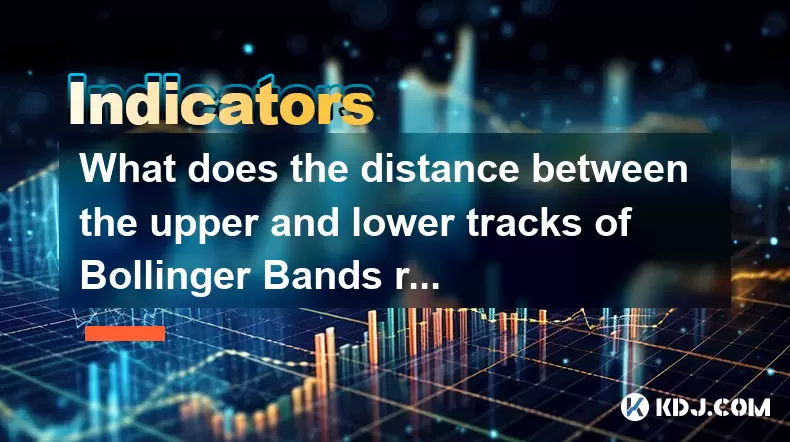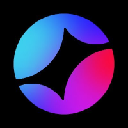-
 bitcoin
bitcoin $114320.977035 USD
-0.40% -
 ethereum
ethereum $4152.439985 USD
-1.75% -
 tether
tether $1.000111 USD
-0.04% -
 xrp
xrp $2.843037 USD
-1.63% -
 bnb
bnb $1013.349380 USD
-1.62% -
 solana
solana $208.362767 USD
-2.10% -
 usd-coin
usd-coin $0.999783 USD
0.00% -
 dogecoin
dogecoin $0.232559 USD
-1.00% -
 tron
tron $0.333491 USD
-1.09% -
 cardano
cardano $0.806310 USD
0.19% -
 hyperliquid
hyperliquid $45.023720 USD
-1.59% -
 ethena-usde
ethena-usde $1.000819 USD
-0.06% -
 chainlink
chainlink $21.241249 USD
-2.11% -
 avalanche
avalanche $30.035416 USD
-0.66% -
 stellar
stellar $0.364984 USD
-2.05%
What does the distance between the upper and lower tracks of Bollinger Bands represent? How to calculate volatility?
The distance between Bollinger Bands' upper and lower tracks indicates market volatility, helping traders assess risk and potential price movements in cryptocurrency trading.
May 22, 2025 at 07:21 am

The Bollinger Bands are a popular technical analysis tool used by traders in the cryptocurrency market to gauge market volatility and identify potential buy and sell signals. The distance between the upper and lower tracks of Bollinger Bands represents the volatility of the market. This distance is crucial as it helps traders understand how much an asset's price is deviating from its moving average, thereby indicating the level of risk and potential price movement.
To understand the significance of the distance between the upper and lower tracks, it's essential to know how Bollinger Bands are constructed. Bollinger Bands consist of three lines: the middle band, which is typically a 20-day simple moving average (SMA); the upper band, which is the middle band plus two standard deviations; and the lower band, which is the middle band minus two standard deviations. The standard deviation is a key component in this calculation because it measures the dispersion of a set of values from their mean, which in this case is the price of the cryptocurrency.
The distance between the upper and lower bands is directly influenced by the standard deviation. When the market is highly volatile, the standard deviation increases, causing the bands to widen. Conversely, during periods of low volatility, the standard deviation decreases, and the bands narrow. This dynamic nature of the Bollinger Bands makes them an effective tool for traders to monitor market conditions and adjust their strategies accordingly.
How to Calculate Volatility Using Bollinger Bands
Calculating volatility using Bollinger Bands involves a few steps that traders can follow to assess the market's current state. Here's how you can do it:
- Calculate the Middle Band: First, determine the 20-day simple moving average (SMA) of the cryptocurrency's price. This will be your middle band.
- Calculate the Standard Deviation: Next, calculate the standard deviation of the same 20-day period. This can be done using statistical software or a financial calculator.
- Determine the Upper and Lower Bands: Add two standard deviations to the middle band to get the upper band, and subtract two standard deviations from the middle band to get the lower band.
- Measure the Distance: The distance between the upper and lower bands is your measure of volatility. A wider distance indicates higher volatility, while a narrower distance indicates lower volatility.
Practical Application of Bollinger Bands in Cryptocurrency Trading
Traders use Bollinger Bands in various ways to make informed decisions in the cryptocurrency market. One common strategy is to look for Bollinger Band squeezes, which occur when the bands come closer together, indicating a period of low volatility. This often precedes a significant price movement, as the market is likely to revert to a state of higher volatility.
Another strategy involves Bollinger Band breakouts. When the price of a cryptocurrency moves outside the upper or lower band, it can signal a strong trend. Traders might buy when the price breaks above the upper band or sell when it breaks below the lower band, anticipating continued movement in that direction.
Interpreting the Distance Between Bollinger Bands
The distance between the upper and lower Bollinger Bands provides valuable insights into market conditions. When the bands are wide, it suggests that the market is experiencing high volatility. This could be due to significant news events, market sentiment shifts, or large trading volumes. During such times, traders might expect larger price swings and adjust their risk management strategies accordingly.
Conversely, when the bands are narrow, it indicates low volatility. This might suggest that the market is consolidating and that a breakout could be imminent. Traders might use this information to prepare for potential price movements by setting up trades that capitalize on the expected increase in volatility.
Limitations and Considerations
While Bollinger Bands are a powerful tool, they are not without limitations. One key consideration is that Bollinger Bands are lagging indicators. They are based on historical data, which means they might not always predict future market movements accurately. Traders should use Bollinger Bands in conjunction with other technical indicators and fundamental analysis to make well-rounded trading decisions.
Another consideration is that the default settings of Bollinger Bands (20-day SMA and two standard deviations) might not be suitable for all cryptocurrencies or market conditions. Traders might need to adjust these parameters based on the specific asset they are trading and the timeframe they are using.
Using Bollinger Bands for Risk Management
Bollinger Bands can also be used for risk management in cryptocurrency trading. By understanding the level of volatility, traders can set stop-loss orders more effectively. For instance, during periods of high volatility, traders might set wider stop-losses to avoid being stopped out by normal market fluctuations. Conversely, during low volatility, tighter stop-losses might be more appropriate.
Additionally, traders can use the distance between the Bollinger Bands to adjust their position sizes. When volatility is high, smaller position sizes might be warranted to manage risk, while larger positions might be more suitable during periods of low volatility.
Frequently Asked Questions
Q: Can Bollinger Bands predict price reversals in the cryptocurrency market?A: While Bollinger Bands can indicate potential price reversals, they do not predict them with certainty. A common signal for a potential reversal is when the price touches or moves outside the upper or lower band and then moves back inside. However, traders should use other indicators and analysis to confirm such signals.
Q: How often should I recalculate Bollinger Bands for cryptocurrency trading?A: The frequency of recalculating Bollinger Bands depends on your trading strategy and timeframe. For short-term trading, you might recalculate the bands daily or even intraday. For longer-term trading, weekly or monthly recalculations might be sufficient.
Q: Are Bollinger Bands more effective for certain cryptocurrencies?A: Bollinger Bands can be applied to any cryptocurrency, but their effectiveness might vary based on the asset's volatility and trading volume. Highly volatile cryptocurrencies like Bitcoin or Ethereum might show more pronounced signals with Bollinger Bands, while less volatile assets might require adjustments to the standard settings.
Q: Can Bollinger Bands be used in combination with other technical indicators?A: Yes, Bollinger Bands are often used in combination with other technical indicators to enhance trading strategies. Common combinations include the Relative Strength Index (RSI), Moving Average Convergence Divergence (MACD), and volume indicators. Using multiple indicators can help confirm signals and improve the accuracy of trading decisions.
Disclaimer:info@kdj.com
The information provided is not trading advice. kdj.com does not assume any responsibility for any investments made based on the information provided in this article. Cryptocurrencies are highly volatile and it is highly recommended that you invest with caution after thorough research!
If you believe that the content used on this website infringes your copyright, please contact us immediately (info@kdj.com) and we will delete it promptly.
- BlockDAG, DOGE, HYPE Sponsorship: Crypto Trends Shaping 2025
- 2025-10-01 00:25:13
- Deutsche Börse and Circle: A StableCoin Adoption Powerhouse in Europe
- 2025-10-01 00:25:13
- BlockDAG's Presale Buzz: Is It the Crypto to Watch in October 2025?
- 2025-10-01 00:30:13
- Bitcoin, Crypto, and IQ: When Genius Meets Digital Gold?
- 2025-10-01 00:30:13
- Stablecoins, American Innovation, and Wallet Tokens: The Next Frontier
- 2025-10-01 00:35:12
- NBU, Coins, and Crypto in Ukraine: A New Yorker's Take
- 2025-10-01 00:45:14
Related knowledge

What is a tower bottom candlestick pattern? Does it have a high success rate?
Sep 22,2025 at 07:18am
Tower Bottom Candlestick Pattern Explained1. The tower bottom candlestick pattern is a reversal formation that typically appears at the end of a downt...

What is a black hole pattern in the MACD indicator? Is it a cause for concern?
Sep 21,2025 at 06:54pm
Bitcoin's Role in Decentralized Finance1. Bitcoin remains the cornerstone of decentralized finance, serving as a benchmark for value and security acro...

How can I use the psychological line (PSY) to determine market sentiment?
Sep 17,2025 at 02:19pm
Understanding the Psychological Line (PSY) in Cryptocurrency TradingThe Psychological Line, commonly referred to as PSY, is a momentum oscillator used...

How can I determine if a double top pattern has officially formed?
Sep 21,2025 at 03:18am
Understanding the Structure of a Double Top Pattern1. A double top pattern consists of two distinct peaks that reach approximately the same price leve...

What is the Golden Valley pattern on the moving average? Is it better than the Silver Valley pattern?
Sep 21,2025 at 02:54pm
Understanding the Golden Valley Pattern in Moving Averages1. The Golden Valley pattern is a technical formation observed in cryptocurrency price chart...

What does a death cross of the RSI in the strong zone (above 50) mean?
Sep 17,2025 at 10:54pm
Understanding the Death Cross in RSI Context1. The term 'death cross' is traditionally associated with moving averages, where a short-term average cro...

What is a tower bottom candlestick pattern? Does it have a high success rate?
Sep 22,2025 at 07:18am
Tower Bottom Candlestick Pattern Explained1. The tower bottom candlestick pattern is a reversal formation that typically appears at the end of a downt...

What is a black hole pattern in the MACD indicator? Is it a cause for concern?
Sep 21,2025 at 06:54pm
Bitcoin's Role in Decentralized Finance1. Bitcoin remains the cornerstone of decentralized finance, serving as a benchmark for value and security acro...

How can I use the psychological line (PSY) to determine market sentiment?
Sep 17,2025 at 02:19pm
Understanding the Psychological Line (PSY) in Cryptocurrency TradingThe Psychological Line, commonly referred to as PSY, is a momentum oscillator used...

How can I determine if a double top pattern has officially formed?
Sep 21,2025 at 03:18am
Understanding the Structure of a Double Top Pattern1. A double top pattern consists of two distinct peaks that reach approximately the same price leve...

What is the Golden Valley pattern on the moving average? Is it better than the Silver Valley pattern?
Sep 21,2025 at 02:54pm
Understanding the Golden Valley Pattern in Moving Averages1. The Golden Valley pattern is a technical formation observed in cryptocurrency price chart...

What does a death cross of the RSI in the strong zone (above 50) mean?
Sep 17,2025 at 10:54pm
Understanding the Death Cross in RSI Context1. The term 'death cross' is traditionally associated with moving averages, where a short-term average cro...
See all articles










































































